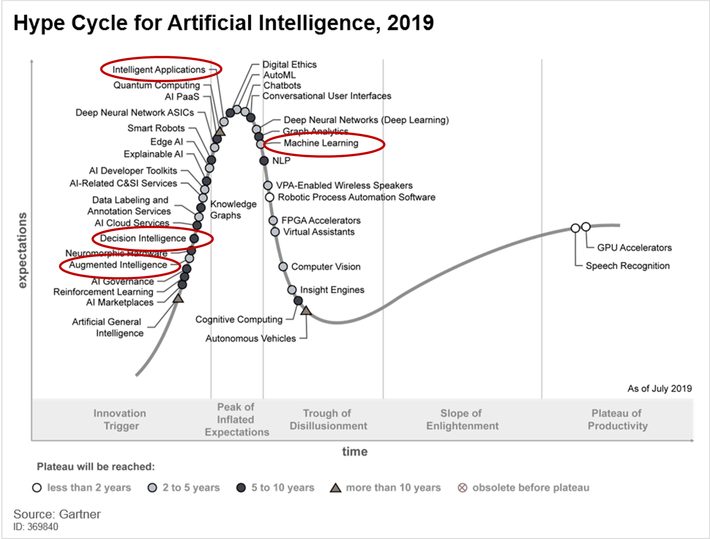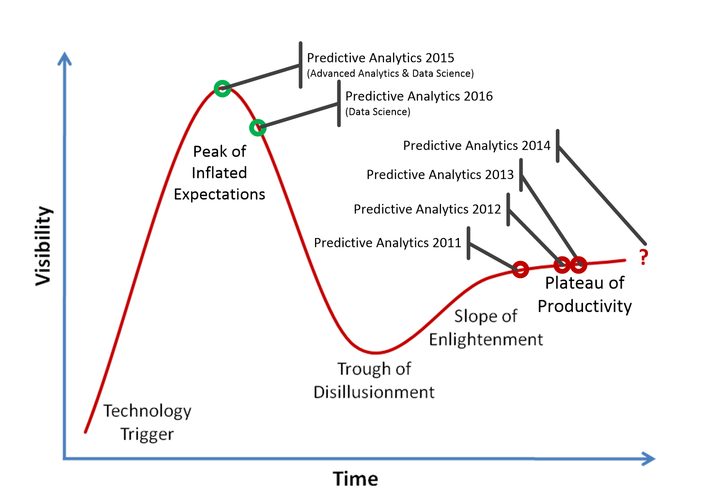Summary: If you’re planning your AI/ML business strategy watch out for the confusion in categories and overly risky ratings given by some research and review sources. Read the research, then consult with your own data scientists for a better evaluation of risk. It’s likely not as bad as you think.

Supposing you’re a business leader and supposing you’re trying to make an intelligent decision about prioritizing your AI adoption plans. It’s likely that like many of us the first thing you’d reach for would be one of Gartner’s many hype cycle or magic quadrant analyses.
What you might not know is that you now need an expert just to guide you through the expert literature. There has been such a proliferation of hype cycles and magic quadrants that you could easily be looking in the wrong place.
For example, in the case of trying to select and prioritize an AI strategy you might logically look at the Hype Cycle for Artificial Intelligence (2019 the most current is above). You might be unaware that there is a completely different Hype Cycle for Data Science and Machine Learning (a little more nuts and bolts) or you might come across the Hype Cycle for Emerging Technologies. All these heavily overlap in the content they review and not infrequently would lead you to draw different conclusions about the maturity of each option.
Even within a single hype cycle analysis there is easily confusion over the mix and overlap of tools versus techniques versus application categories. To illustrate, take a look at our foundational techniques of machine learning, predictive and prescriptive models.
If you’re a definitional purist you might want to put reinforcement learning in here as well but as Gartner points out and as we practitioners are aware, RL is too immature for wide business adoption. Here’s how this bedrock mature set of techniques ends up at four different locations on the maturity curve with three of the four showing still too early for adoption.
Machine Learning:
The Gartner narrative correctly identifies ML as “one of the hottest concepts in technology, given its extensive range of impacts on business.” As we all understand ML can be used to address the lion’s share of data science opportunities in this Gartner list ranging from “automation, customer engagement, supply chain optimization, predictive maintenance, operational effectiveness, workforce effectiveness, fraud detection, and resource optimization”.
It’s positioning, falling into the trough of disillusionment would certainly mislead non-data scientists into believing this is still a high risk set of tools. Clearly it is not.
We wrote about this over two years ago, as Gartner had consistently promoted predictive analytics down the curve until 2014 when it graduated completely off the curve, a measure of full maturity. Only to reappear in 2015 and 2016 moved back to an immature status? No explanation ever given for this reversion.

Ask your data science team and they will confirm for you that ML is a fully mature set of techniques and worth your immediate investment.
Decision Intelligence
Gartner says predictive and prescriptive analytics have been subsumed into this more general category of ‘Decision Intelligence’. In fact these are the only two true data science techniques in this category, wrapped in general management disciplines of “decision support, continuous intelligence and process management”.
Gartner conflates DI with large scale automated decision making and augmented intelligence but ignores the fundamental and well tested decision support role ML plays in all sorts of large and small decision making (see the category list in Machine Learning above).
By apparently focusing only on very wide application of automated decision making, Gartner concludes the DI will take another 5 or 10 years to reach the Plateau of Productivity. Assigning this high risk, early innovation status to our basic tools, decision makers would be discouraged from investing here.
Augmented Intelligence
Augmented Intelligence is another technique that seems to get a bad rap as too early and therefore too risky to adopt. At its core Augmented Intelligence, also known as Centaur Intelligence (half man half machine) is simply a modified version of Decision Intelligence in which ML is used to identify optimum alternatives but the selection of the actual action is left to humans who may better be able to parse the more subjective elements of the situation.
Where fully automated decision making might be seen as too mechanistic, Augmented Intelligence is a heuristic adaptation of ML to the messy, subjective side of dealing with business problems, both internal, and with customers and prospects.
It also recognizes that humans may be better in selecting between two alternatives (for example next best offer when on the phone with a customer) based on the dynamics of their interaction.
Intelligent Applications
Intelligent Applications, perhaps most correctly categorized as barely across the line in the ‘Peak of Inflated Expectations’ describes “enterprise applications with embedded or integrated AI technologies to support or replace manual human-based activities via intelligent automation, data-driven insights, and guided recommendations to improve productivity and decision making”.
This is an area of huge activity in the data science community, to which Gartner correctly adds the admonition to watch out for ‘AI washing’, false claims of real AI inside.
How to Correctly Interpret All This
So what is the business planner to make of all these overlapping categories with distinctly different risk ratings based on their maturity? And why, since all of these are based on core ML techniques of predictive and prescriptive analytics, are they considered so early on the risk curve?
If you have a team of data scientists to help you parse these decisions they should be able to reassure you that the underlying data science is solid and mature. They should also be able to help you assess the risk and reality of any “AI inside” that an application a vendor proposes, and even guide you on when decision making can be fully automated (as it frequently is in Intelligent Automation / Robotic Process Automation) or when it’s best to have the AI suggest and let the humans decide.
For my money, these risk ratings from Gartner are far too severe and will only slow down adoption. By all means consult all these Gartner reports, but consult your in house data science team about the true risks and benefits of these techniques.
Other articles by Bill Vorhies
About the author: Bill is Contributing Editor for Data Science Central. Bill is also President & Chief Data Scientist at Data-Magnum and has practiced as a data scientist since 2001. His articles have been read more than 2.1 million times.
